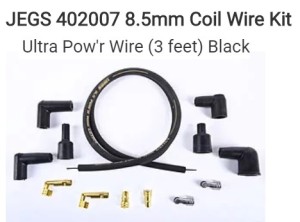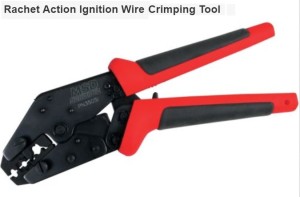Build your coil wire is as a result of a Colonial Region member recently pointing out that a newly purchased Secondary Ignition Wire Set did not have a coil wire included. Spark plug wires were the only furnished item.
Cars 40 years or older are in the hands of enthusiasts with many different goals ranging from 100% originality to highly modified. Ignition systems may vary from points ignition to early electronic to HEI with component combinations of each. Connections vary as well as the voltages they carry so manufacturers are likely to finally give up on supplying one complete custom Chrysler Product set that serves all……. to supplying components and letting the enthusiast plug and play to meet their goals.
Build your coil wire primary reasons however may be driven by your own desire to have the lowest coil wire resistance possible while meeting the connection needs of your setup as well as the best route from the coil to the distributor cap. If you have read some of the following Restoration Articles you may have grasped the importance of lowering your coil wire resistance and getting the best route in order to maximize spark at the plug, maximize distributor cap/rotor life, maximize electronic ignition reliability, and minimize cross firing:
- http://www.plymouthcarclub.com/2018/01/distributor-caprotor-quality-check/
- http://www.plymouthcarclub.com/2018/03/distributor-cap-quality-part-2/
- http://www.plymouthcarclub.com/2017/01/secondary/
- http://www.plymouthcarclub.com/2016/12/measuring-ignition-health/
- http://www.plymouthcarclub.com/2015/08/flathead-6-crossfiring/
When you give your car a physical each year included on the list is a check of the secondary ignition line resistances since you are looking for wire deterioration. Example of part of the data for a physical:
| Dart Physicals | 2018 | ||||
| Resistance | Length | ohm/in | sec. | Plug | |
| Secondary Ign | kilo ohms | inches | kvolt | Color | |
| Coil Wire | 0.48 | 9 | 0.05 | 16 | |
| #1 Plug Wire | 2.42 | 12 | 0.20 | 17 | tan |
| #2 Plug Wire | 1.65 | 9 | 0.18 | 18 | tan |
| #3 Plug Wire | 1.47 | 8 | 0.18 | 16 | tan |
| #4 Plug Wire | 1.48 | 8 | 0.19 | 15 | tan |
| #5 Plug Wire | 2.12 | 12 | 0.18 | 17 | tan |
| #6 Plug Wire | 2.05 | 11 | 0.19 | 18 | tan |
| Revs | Vacuum | Oil Pres | Air/Fuel | ||
| Hot Idle | RPM | In WG | psi | Ratio | |
| 750 | 19.5 | 42 | 13.9 | ||
| Compression | psi | ||||
| #1 | 135 | ||||
| #2 | 137 | ||||
| #3 | 140 | ||||
| #4 | 140 | ||||
| #5 | 135 | ||||
| #6 | 140 |
Notice how the coil wire resistance (.05 ohm/in) is so much lower than the spark plug wires; it is a result of making your own coil wire.
The coil wire gets challenged 4, 6, or 8 times faster per unit time than a spark plug wire. The coil wire also directly influences everything downstream while a particular plug wire has a less limited range of influence. A focus on the coil wire is appropriate if your addressing highest priority items first.
You may find it slightly challenging to find, purchase, and optimize the coil wire for best reliability of the Secondary Ignition system on early Chrysler Products. Choices sometimes range from a coil wire found in a universal wire set to purchasing a high end “custom” larger diameter wire set sold exclusively for the application. Look closer and find the coil wire is not the minimum length it could be or have the best connector configurations for your application. A “General Application” type set is being listed as a fit for your engine & car configuration.
Making your own coil wire will give you several opportunities to get the lowest resistance in the circuit by:
- Minimizing length of the coil wire
- Selecting largest wire diameter possible
- Selecting best coil wire connector configurations for your coil and cap connections
- Best coil wire connector fastening technique to the coil wire
Compare a high end “Custom” wire set for a slant six to a unique coil wire applying all of the above opportunities. Forget appearances and go to a resistance measurement & coil wire voltage measurement comparison. The comparison is only valid if you conduct it without changing anything else in the secondary circuit.
So how do you go about making a unique coil wire sized and configured for your unique early model Chrysler product?
- Get a kit with a large diameter wire with super thick insulation properties & assorted connector/boot options such as

- Utilize the best tool for securing the connectors firmly

- Cut the wire to length to suit a route appropriate to insure no cross firing, shortest wire possible, and satisfying the connector orientation.
- Measure final coil line resistance from connector to connector to assure that the coil of lowest coil line resistance has been achieved
- Install coil wire and test coil wire voltage to verify the result is an improvement over the original coil wire voltage. Less voltage is an improvement.
Sometimes your super wire may not be so super in another department…….static on your radio or even the car sitting next to you. Something to consider before launching on your mission.
The Colonial Region has the special terminal crimper to get the job done for wire sizes up to 8.5mm so just holler.
As for our Colonial Region Member who felt short changed by not having a coil wire in the engine set consider that as an opportunity to have a much better one.
Vector Files:
Why Build Your Own Ignition Coil Wire (.psf)
Why Build Your Own Ignition Coil Wire (.doc)
